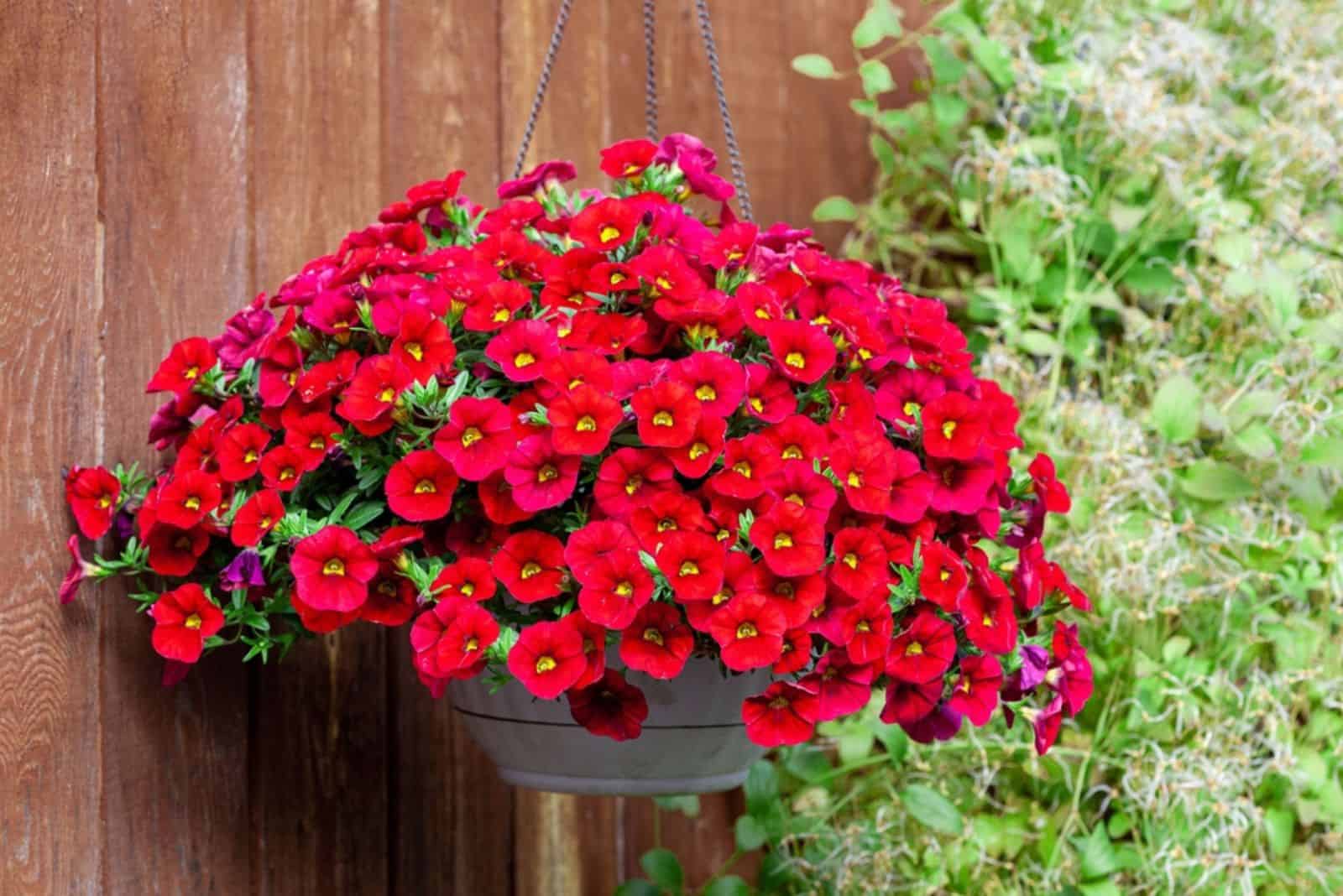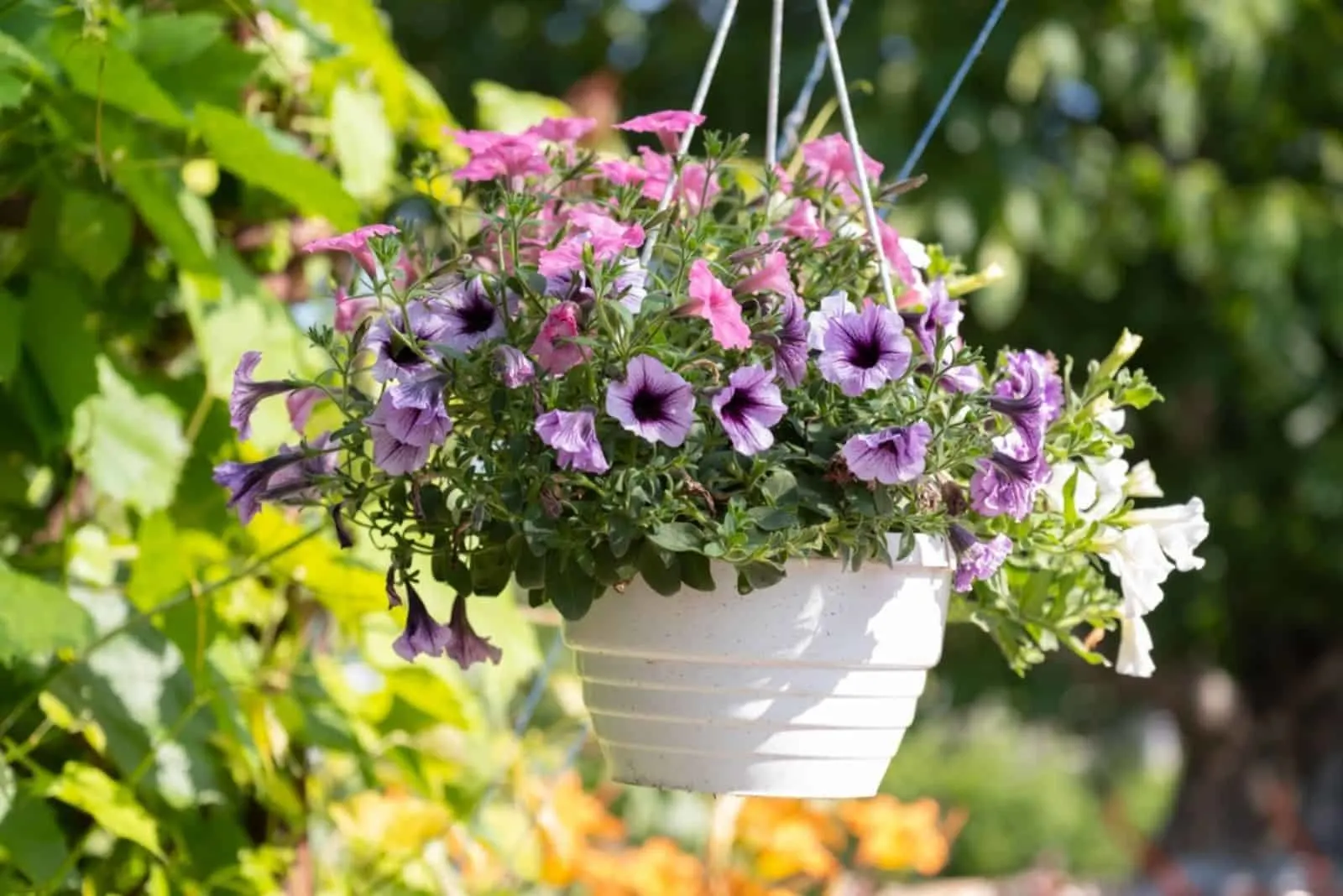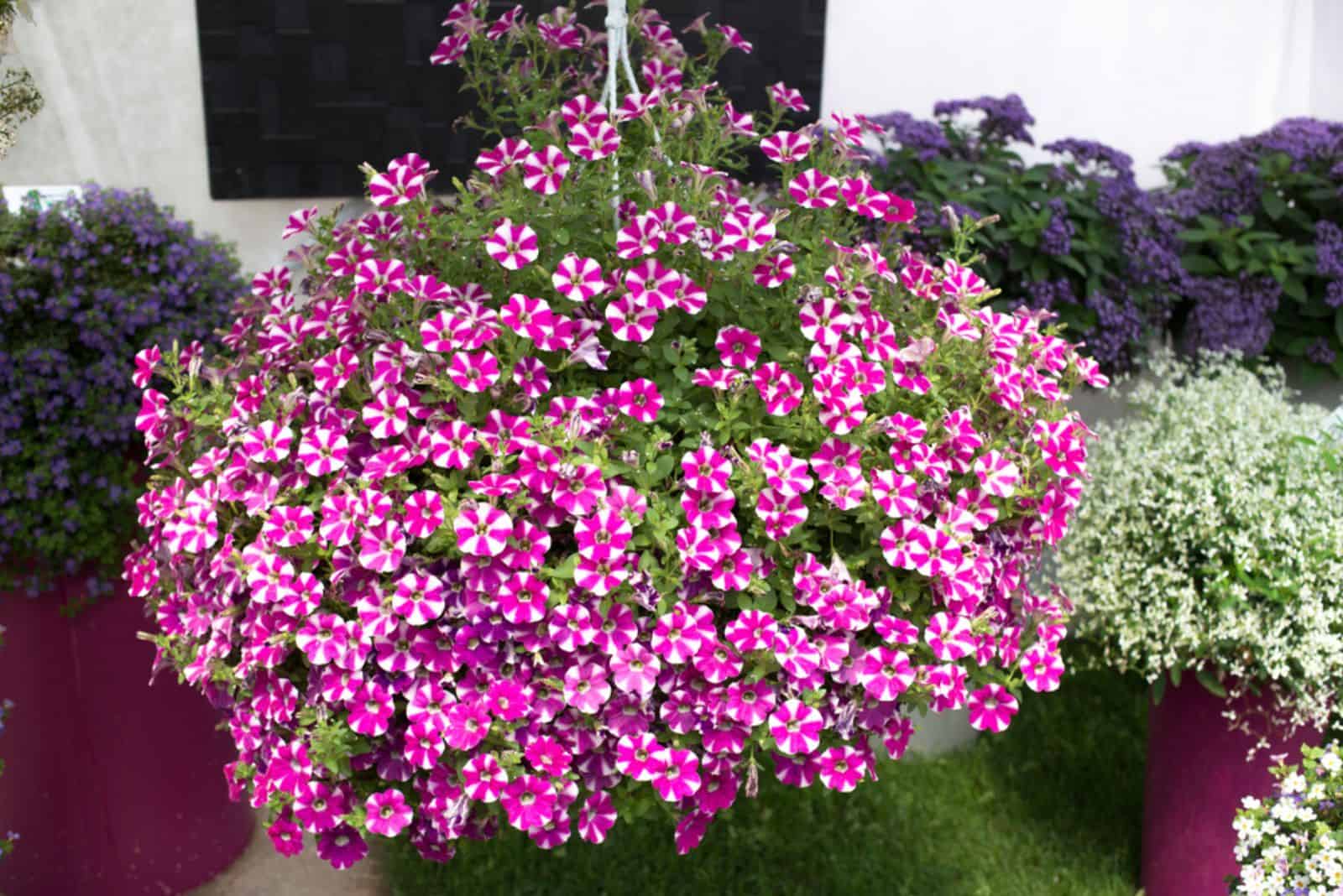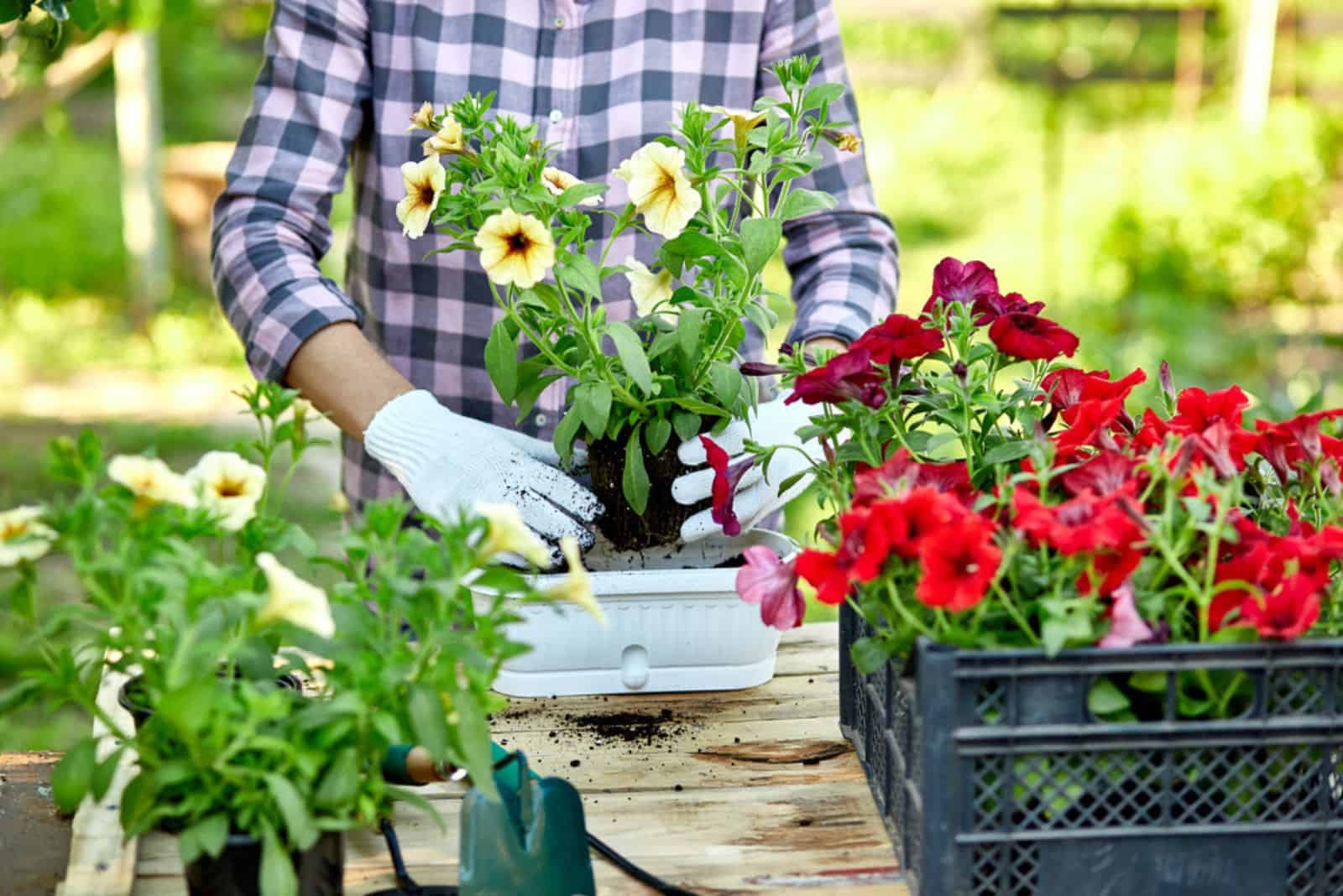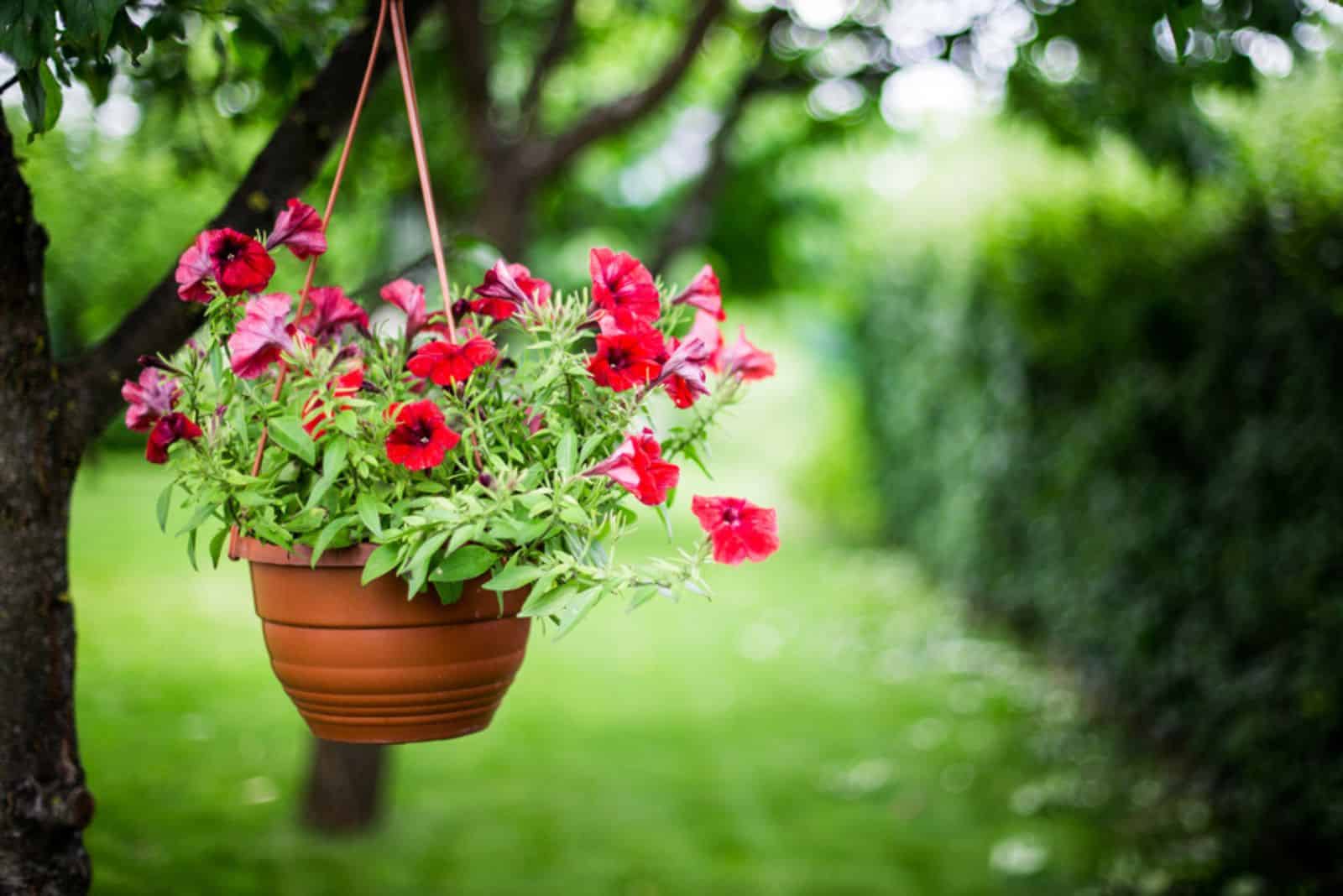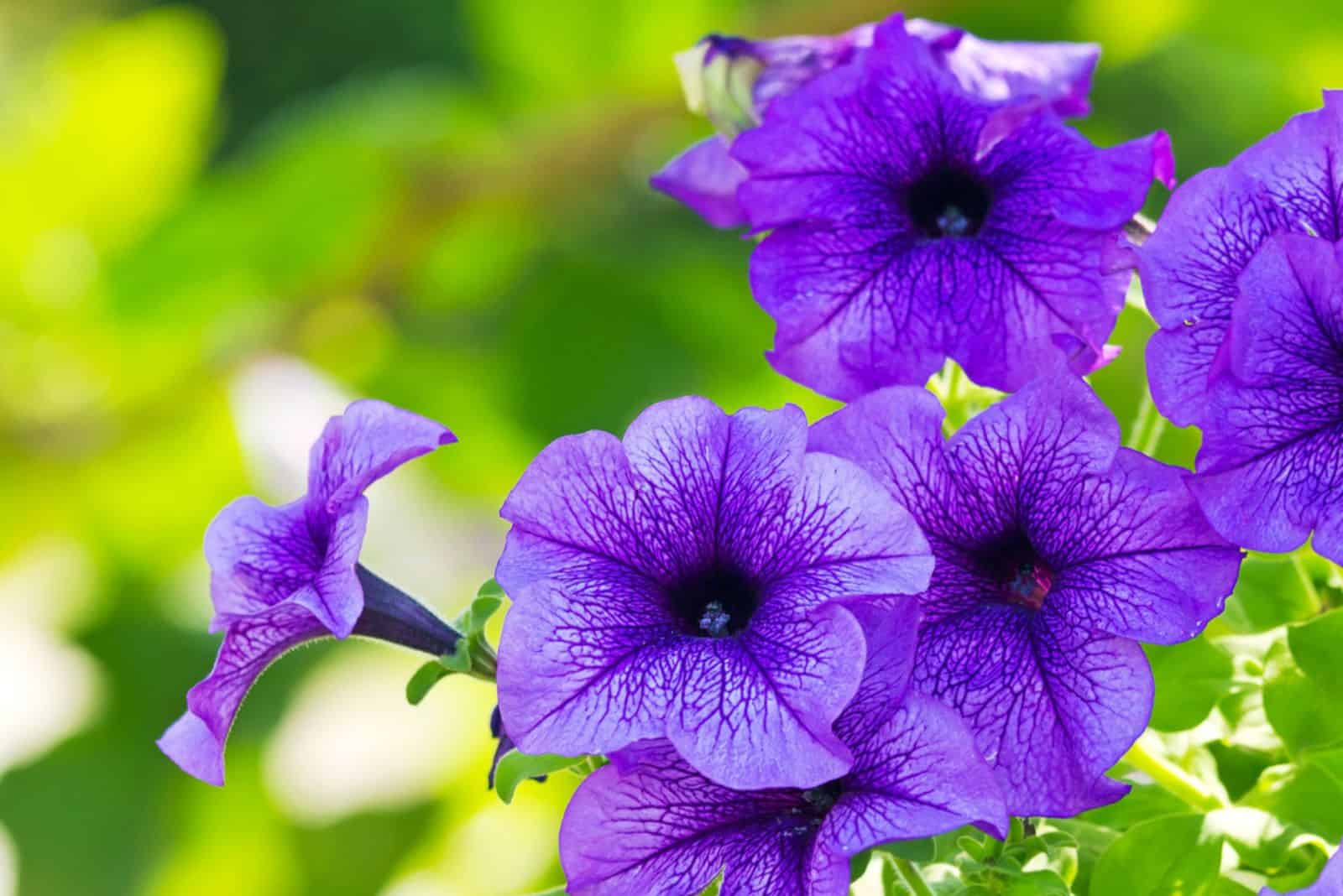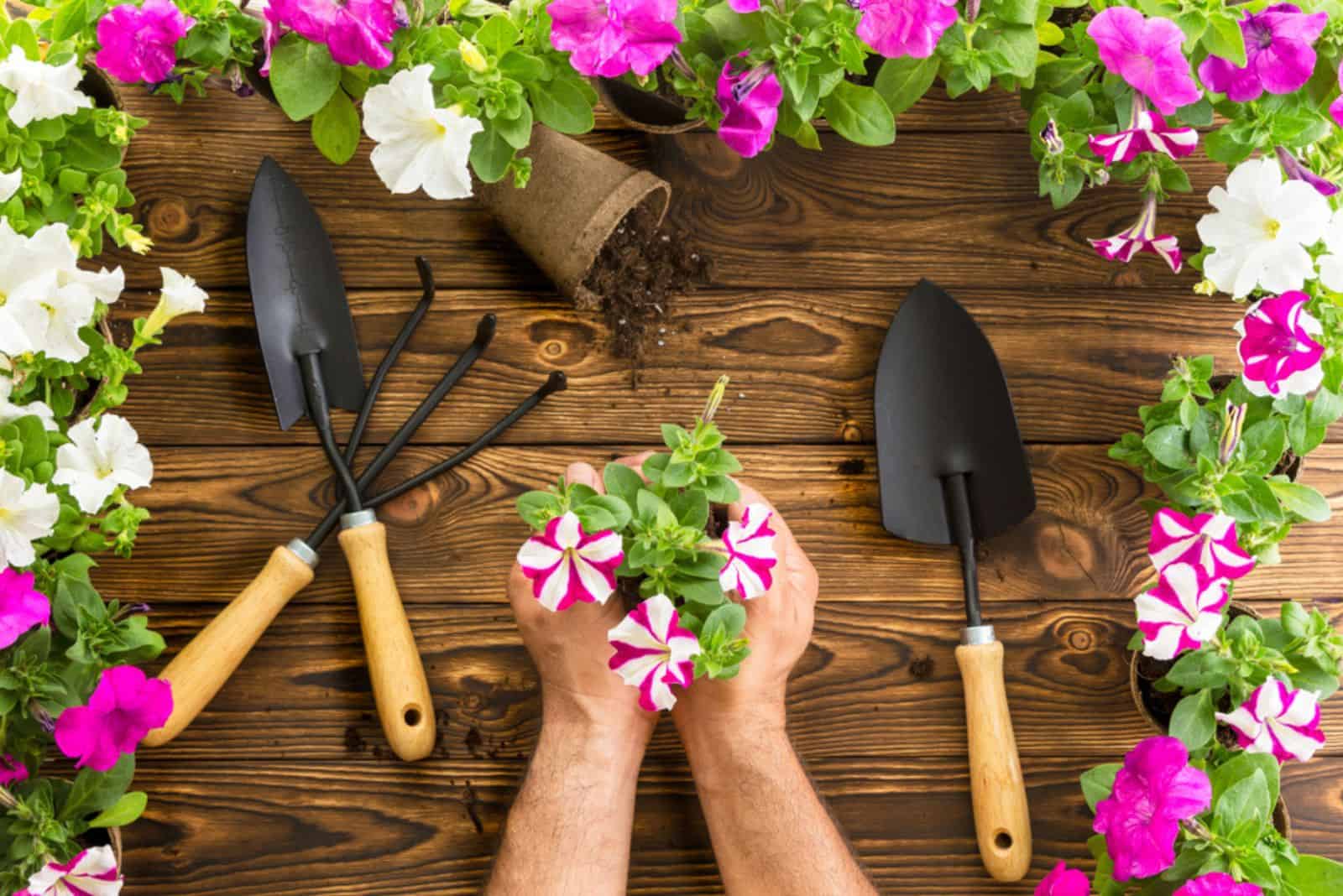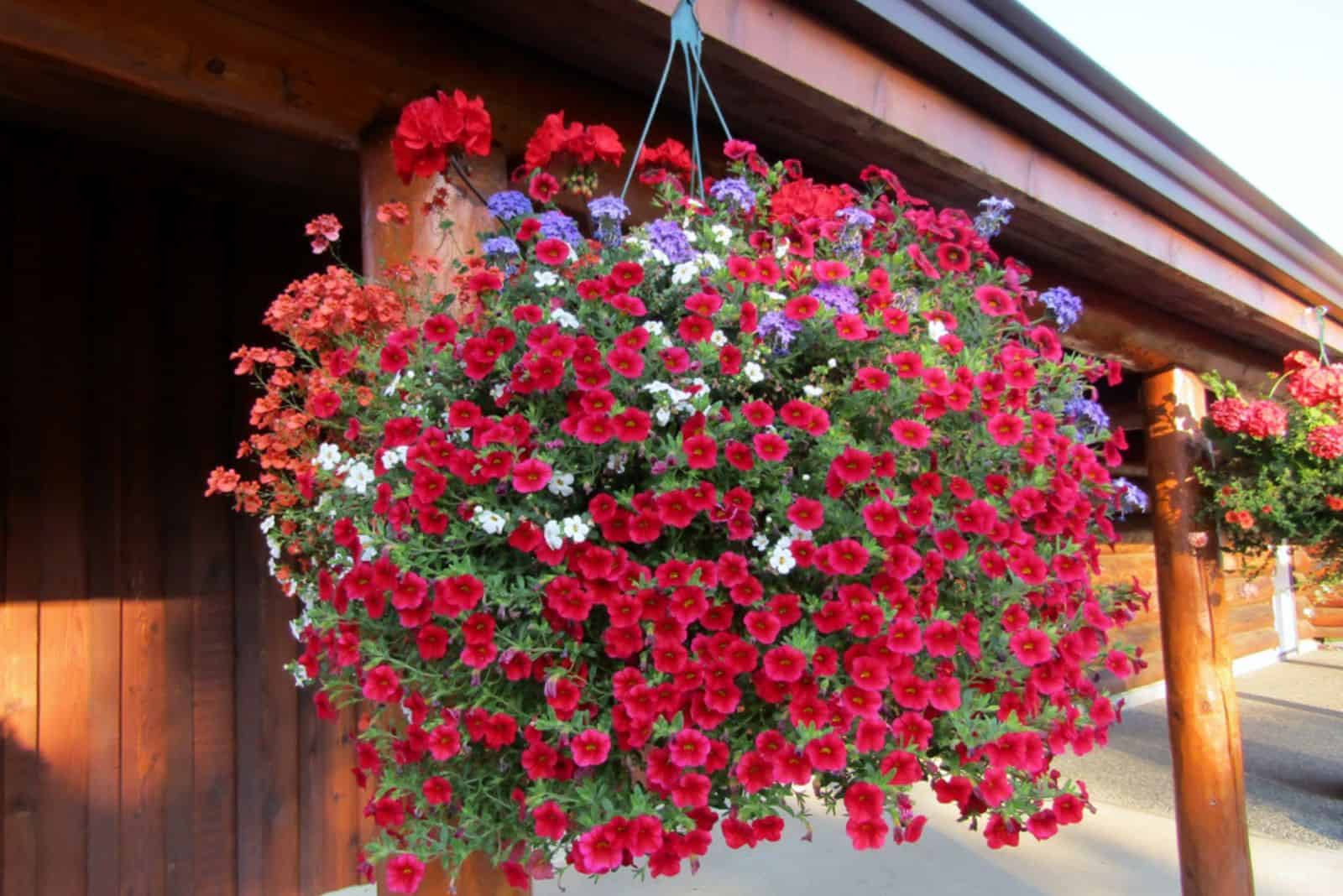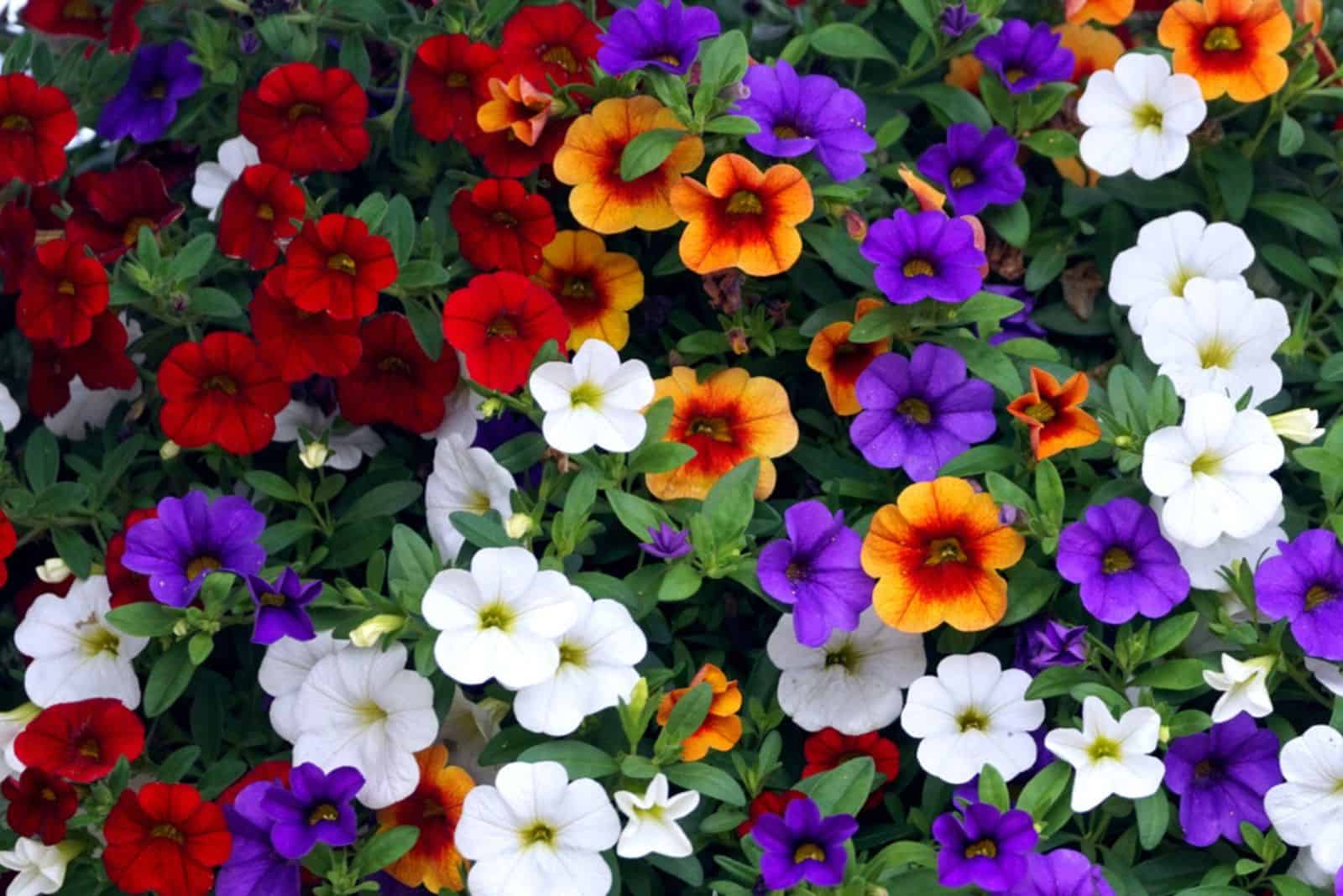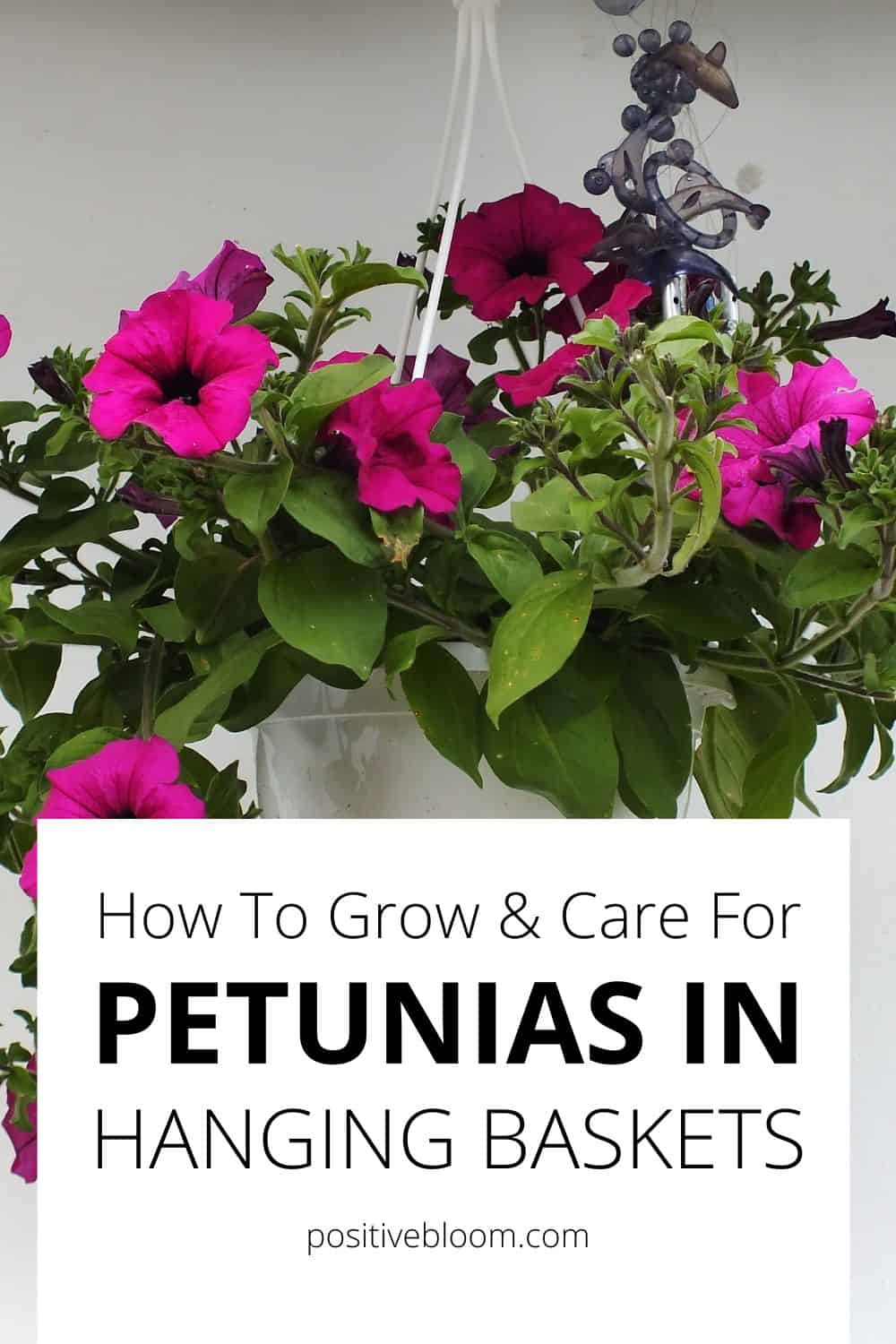Petunias are long bloomers whose flowers we can admire from spring until the frost says: “No more!”.
One of the things most growers love about this plant is that you can grow it in your garden, in pots, or hanging baskets.
There’s nothing more attractive than a balcony adorned with flower baskets or a patio with planters raining beautiful petunia plants!
This article will discuss many things regarding the growth and care of petunias in hanging baskets.
Before we get there, let’s learn more about this species:
[table id=491 /]
Growing Petunias In Hanging Baskets
Petunias belong on the list of flowers that attract hummingbirds and butterflies, so they’re perfect for pollinator gardens.
But how do you grow them successfully in hanging planters?
To grow petunias in hanging baskets, you need to choose a suitable variety, pick the proper pot, prepare a well-draining potting soil, and then plant them.
This section will even discuss overwintering these beauties, so don’t miss out!
Choose Proper Petunia Varieties
There are many species of petunias, and you can choose them based on their growth habits.
You can grow these flowers as either annuals or perennials based on your climate. Petunias are usually hardy in USDA zones 10-11, so if you live north of these regions, you’ll have to enjoy them as annuals.
Or will you?
Petunias respond well to overwintering, and we’ll talk more about this in the last section!
There are also shaded and full-sun petunias, so first consider the location before getting any variety. Shaded petunias can survive in light shade, but most varieties thrive when they get at least six hours of sunlight each day (or more).
Wave Petunias
This variety spreads easily and bears many blossoms you’ll enjoy come summer. The flowering will continue well into the fall if you live in a region with a mild climate and they get full sunlight.
One of the things gardeners simply adore about this species is that you don’t have to deadhead them; they self-clean, so to speak.
They are usually annuals but can live as perennials in the USDA hardiness zone 11.
Supertunias
Supertunias are a newer breed of petunias that have a mounding growth habit. They look amazing in regular planters and can look stunning in hanging baskets.
This summer flower resembles a large ball when grown in hanging planters and is an essential part of any beautiful display for warm summer parties.
This trailing variety is usually grown as an annual, but if you live in warm climates, you can enjoy its blossoms for many years to come.
Supertunias are slightly hardier than wave petunias, more colorful, and more disease-resistant, but they’re both avid growers that’ll provide lush, vibrant, and abundant flowers.
Choose A Proper Planter
Once you settle on the variety you wish to plant, it is time to choose a suitable hanging basket. Generally speaking, planters with at least one drainage hole are necessary because they keep your plant safe from overwatering and root rot.
You should also look for terracotta planters as they ensure proper drainage as well. Plastic pots retain much more water, and iron ones can get really hot in the summer.
Of course, you can use plastic planters, but you might need to water your petunias less frequently.
Don’t worry if you can’t seem to find a perfect pot for your petunia plants. You can watch this full video and learn some DIY tricks for turning any pot into a hanging basket:
Prepare The Potting Mix
Petunias don’t like compacted and heavy substrates, so garden soil isn’t the best option for this plant. Ready-made potting soils are much more suited because they have optimal drainage and aeration.
But if you prefer utilizing materials you have at home, you can use your native soil, just not on its own. Mix it with materials that improve drainage, such as compost, vermiculite or perlite, and peat moss.
Once the potting soil is ready, add some slow-release fertilizer before planting to give your plants an additional boost. If the store-bought mix contains plant food, you don’t have to add more nutrients!
Plant The Petunias
These plants are very sensitive to cold temperatures, so the best time for planting is sometime in late spring or even early summer if you live in cooler regions.
You can plant them a bit earlier, but in that case, you’ll have to keep them inside until the weather is warm enough.
Fill the basket with the growing medium, place the petunia in it, and backfill it with more soil.
You can also grow more than one petunia plant per basket, but how many depends on the variety you choose and the size of the planter.
Have you ever wondered how many petunias you can plant in a single hanging planter?
Shaded petunias generally need to be 5-6 inches apart, whereas full sun varieties need to be a foot apart.
After planting the petunias, water them slowly until you notice that the excess has started to drain out through the hole in the bottom.
Overwintering A Hanging Basket Of Petunias
If you don’t want to plant new petunias every year, you can always overwinter them somewhere warm.
You can move a hanging basket of petunias indoors and place it in a bright spot where it will continue growing (and blooming if you’re lucky).
The other way to overwinter these plants is to induce dormancy. You can achieve this by moving it to a spot with low light that’s slightly cooler, such as a garage or basement. The key is to keep it away from frost. Also, you shouldn’t keep it in complete darkness.
The plant won’t show any new growth in this state and will resume growing once the warm temperatures of spring arrive.
Petunia Hanging Basket Care: 6 Gardening Tips
If you know the care guide for the black magic petunia or any other species, you can use that knowledge to grow petunias in hanging baskets.
Sometimes the pruning requirements are slightly different, but this plant generally needs full sun, well-draining soil, and frequent watering (especially during hot summer days).
We’ll discuss these things in more detail in the following sections so that you can adorn your patio with these beautiful flowers!
Light Requirements
Petunias require full sunlight for the best and most abundant blossoms, but certain varieties can tolerate partial shade.
However, they might turn leggy, and you’ll end up with a lot of additional pruning work once the summer comes.
Water And Humidity
Petunias grown in hanging baskets or containers generally dry out much more quickly than ones planted in soil.
Therefore, you’ll have to irrigate them more frequently, especially during heat and dry spells (when they might require watering twice a day).
The best way to check whether your wave petunia (or supertunia) needs more moisture is to examine the soil. If it’s dry and light, you should water your colorful flower.
Keep irrigating them until you notice that the excess has started to drain out through the drainage hole.
Humidity
Petunias thrive in low-humidity environments, so they’re perfect for drier climates.
If you live in a tropical region, place the plants a few feet apart to ensure proper airflow and irrigate them less frequently.
(But always check the topsoil before watering!)
Temperature
These plants adore warm temperatures, and anything between 60-80°F during the day is ideal. The nighttime temperatures should be slightly cooler, between 55-65°F.
Petunias cannot handle the cold, and anything below 40°F would be the death of them. That’s also the reason they’re usually grown as annual plants.
But if you take them inside and protect them from freezing temperatures during winter, they can last a couple of years.
Soil And Fertilizer
Petunias require well-draining and fertile growing mediums with neutral pH.
If you don’t feel like buying huge batches of soil every time these hangers require repotting, you can make it yourself. Mix some compost or organic matter and perlite into your garden soil and plant your petunias.
Fertilizer
Petunias benefit from slow-release fertilizer when planting. You can also add phosphorus and potassium-rich water-soluble fertilizer before the plants start blooming to encourage more numerous and gorgeous blossoms.
You don’t necessarily have to use fertilizers, but they are more concentrated than other organic matter. Understanding the differences between compost and fertilizer can help you choose the best source of nutrients for your plants.
Plant Propagation
Gardeners all over the world propagate supertunias or wave petunias from cuttings or seeds, and it all depends on how patient you are and what kind of plants you need.
Propagation from cuttings creates clones of the mother plant, so if you already have a breathtaking mounding petunia in your garden, you can multiply it before it withers from old age.
Petunia Cuttings
Propagating petunias from cuttings is relatively simple:
Step 1. Choose a few healthy stems and cut them right below the leaf node. Remove the flowers so that the new root system can develop without hindrance. Peel the bottom leaves as well because they’re not needed.
Step 2. Dip them in rooting hormone before planting them into a seed-starting mix. Ensure that each cutting is at least an inch apart from its neighbors if you don’t have a nursery tray with individual cells.
Step 3. Water the growing medium and maintain constant moisture! Put a humidity dome or cover the cuttings with plastic bags to increase the humidity.
Step 4. Keep the pot or nursery tray at room temperature and in a spot with indirect light to speed up its development.
Step 5. You’ll soon notice new growth, and if you’re unsure whether your plant has put on any height, you can always try to pull it out of the medium. If the new petunia offers resistance, the root system has developed.
Step 6. Leave the young plants in nursery trays for a few weeks, then transplant them into larger pots.
Below, you can find more tips for propagating petunias from cuttings:
Petunia Seeds
Planting petunia seeds is even simpler than propagating the plant from cuttings. Just take a couple of seeds, plant them into a damp seed starting mix, and sprinkle them with more soil. Leave them at room temperature wherever you want because they don’t require sunlight during this stage.
In about a week, the seeds will germinate, and you can gradually expose them to more light.
Just remember to keep the growing medium moist. Once the young plants gain in size and develop true leaf forms, the growth speed will increase, and you’ll soon have to transplant them into larger containers.
Pruning Petunias
Petunias benefit from regular pruning, especially in mid-summer when most growers advise cutting back about 1/3 of the entire plant.
Generally speaking, you should trim these plants three times during summertime, starting at the beginning of July. Keep pruning your petunias in mid-August and mid-September, and remove about 1/3 of the plant (focusing on the leggy parts).
Growing Petunias With Other Perennials: Final Garden Answer
You can grow a couple of petunia plants in a single hanging basket, especially if it’s a larger one, but did you know that you can also combine it with other species?
Petunia plants get along amazingly with other similar perennials, such as geraniums, hydrangeas, and calibrachoa.
You can also research the meaning of petunias and plant them with other plants that signify hope and serenity.
But beware! All these plants can fall victim to aphids, mealybugs, and spider mites, so monitor them closely and start treating them as soon as you notice the first signs of infestation. Ladybugs can help you with this, or you can use horticultural oils.
Geranium
One of our favorite companion choices for petunias in hanging baskets are geraniums. These plants are taller than petunias and can add more texture and dimension to your patio decor.
Geraniums can also thrive in full sun and well-draining and fertile soil, so you’ll be able to easily care for these plants.
And just imagine what an exquisite combination of tall geraniums in the middle and hanging petunias running from the sides of the planter would be!
Calibrachoa
The Calibrachoa resembles petunias in many ways, but it has smaller blossoms that can add a nice contrast to your hanging basket.
Both plants have similar pruning and care needs, which will help you with your chores.
Petunias are more vigorous growers, so you should plant more calibrachoa and fewer supertunias for a balanced flower design.
Hydrangea Cuttings
Petunias and hydrangeas are both traditional garden plants that you can even start in the same nursery tray.
They have the same needs and will provide you with a unique display all your visitors will love.
Hydrangeas and petunias are so different that many would question growing them in the same container. But petunias cascading from the planter sides would bring out the best of hydrangea balls.
FAQ
The last section of this article deals with common questions you asked us about petunias in hanging planters.
Let’s start!
How long do petunias last in hanging baskets?
Petunias are short-living perennials that usually last about 2-3 years when grown in baskets in USDA zone 11 or when overwintered.
However, these plants are vigorous growers you can plant every year to enjoy their abundant blossoms.
How high should I hang a hanging petunia basket?
The exact height isn’t particularly important, but you should aim for a place where the plant will get at least six hours of sunlight per day and where it won’t bother you when passing it.
Can petunias be grown in hanging baskets indoors?
Yes, you can grow petunias in hanging baskets indoors, but you should find a place where they can bask in the sunlight for at least six hours a day.
The best thing you can do is grow this plant outdoors during warm seasons and then take it inside over winter.
Final Thoughts
Growing petunias in hanging baskets is simple and can improve your outdoor decor tremendously. You just have to find a suitable variety (preferably the one that produces the most blossoms), choose a basket with a drainage hole, and plant your beauty in well-draining soil.
From there, all you need to do is ensure that your plant is in a sunny spot, water it when the topsoil dries out, and feed it occasionally to increase bloom production.
You can also grow supertunias and wave petunias with other plants, such as hydrangeas, geraniums, and calibrachoa, for a more unique display.
Enjoy this gorgeous bloomer, and until next time!
Like this post? Share or pin it for later!

